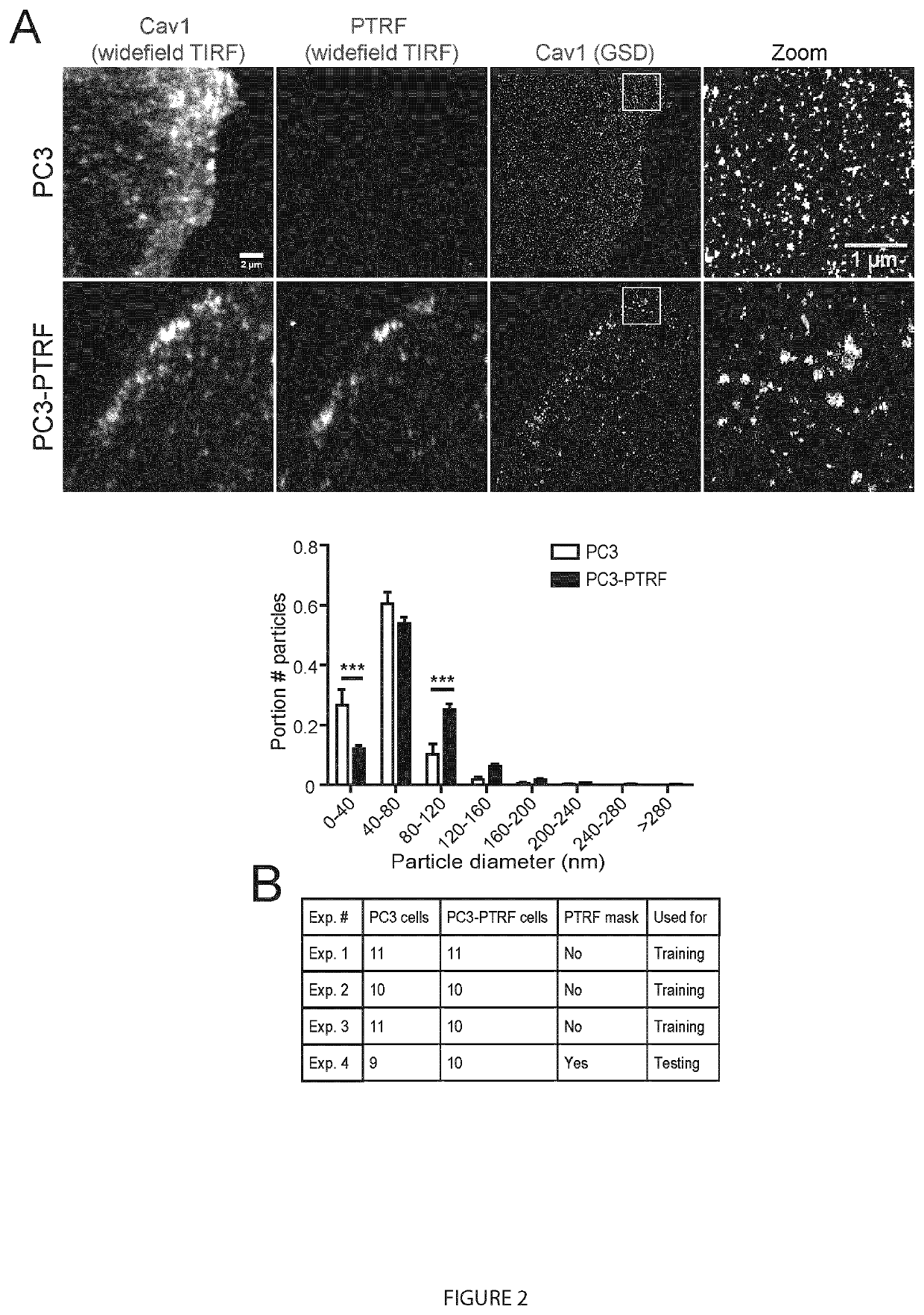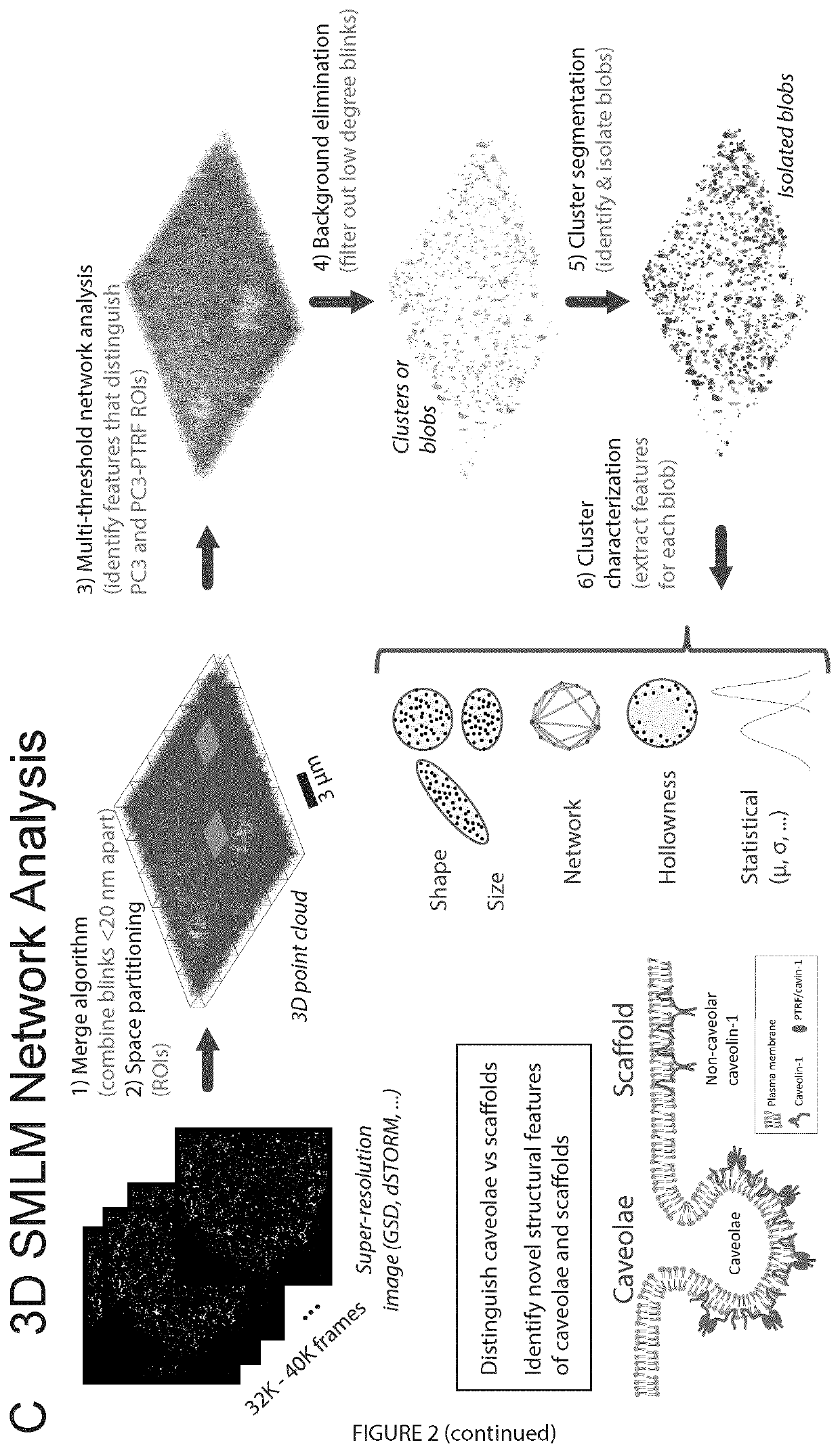Methods for analysis of single molecule localization microscopy to define molecular architecture
a localization microscopy and molecular architecture technology, applied in the field of superresolution microscopy, can solve the problems of inability of second-order statistics to deal with localized shape and size properties of homogenous clusters, computational intensive ripley's function calculation, and inability to handle millions of points
- Summary
- Abstract
- Description
- Claims
- Application Information
AI Technical Summary
Benefits of technology
Problems solved by technology
Method used
Image
Examples
example 1
Introduction
[0086]In this example, a 3D point cloud (Botsch et al., 2010; Aldoma et al., 2012; Berger et al., 2014) was used to model SMLM data. Virtual connections between points transform the point cloud into a network modeled computationally as a graph with nodes (or vertices); edges are connections between nodes (points) that weight the distance between nodes. Such network representations have been widely and successfully adopted for analysis of brain, social and computer networks (Barabasi and Oltvai, 2004; Newman, 2010; Baronchelli et al., 2013; Sporns, 2013; Brown et al., 2014). Using machine learning approaches, features that distinguish networks were identified and used to understand the underlying organization or architecture of the network. Here point cloud network analysis was applied to SMLM data sets to define the molecular architecture of plasma membrane associated caveolae and caveolin-1 (Cav1) scaffolds.
[0087]Formation of caveolae, 50-100 nm plasma membrane invagina...
example 2
olution Modularity Analysis Shows that Polyhedral Caveolin-1 Oligomers Combine to Form Scaffolds and Caveolae
Introduction
[0114]Of the various super-resolution microscopy approaches, the best resolution is obtained using single-molecule localization microscopy (SMLM), based on the repeated activation (blinking) of small numbers of discrete fluorophores, usually through dSTORM. Precise localization of these blinks is determined from a Gaussian fit of the point-spread function (PSF) providing ˜20 nm X-Y (lateral) resolution and ˜25-50 nm Z (axial) resolution for astigmatic lens 3D SMLM (Huang et al., 2008; Shroff et al., 2008). SMLM generates point coordinates in 3D space that can then be
[0115]used to reconstruct localizations with significantly improved resolutions. An alternate approach to study point distributions is to visualize them as a graph or network. Graphs are mathematical structures used to model interactions between entities for many systems, with the entities represented ...
example 3
ation of Caveolin-1 Domain Signatures Via Graphlet Analysis of Single Molecule Super-Resolution Data
Introduction
[0134]Graphs are ubiquitous and powerful mathematical structures used for modeling objects and their interactions. Graph-based network analysis have been used in many fields of study and helped in understanding the behavior of many systems. The network is a set of items known as nodes, with connections between them, known as edges (Newman, 2003). There are many successful realworld examples of leveraging network in analyzing social, computer, brain, and biological networks (Newman, 2003, Bassett and Sporns, 2017, Krivitsky et al., 2009, Costa et al., 2008, Zitnik and Leskovec, 2017, Brown et al., 2014). Recently, a graph-based complex network analysis clustering method (Khater et al., 2018) was used to analyze the 3D point cloud of single molecule localization microscopy (SMLM) super resolution microscopy data. The method consists of an integrated pipeline that can be used...
PUM
 Login to View More
Login to View More Abstract
Description
Claims
Application Information
 Login to View More
Login to View More - R&D
- Intellectual Property
- Life Sciences
- Materials
- Tech Scout
- Unparalleled Data Quality
- Higher Quality Content
- 60% Fewer Hallucinations
Browse by: Latest US Patents, China's latest patents, Technical Efficacy Thesaurus, Application Domain, Technology Topic, Popular Technical Reports.
© 2025 PatSnap. All rights reserved.Legal|Privacy policy|Modern Slavery Act Transparency Statement|Sitemap|About US| Contact US: help@patsnap.com



